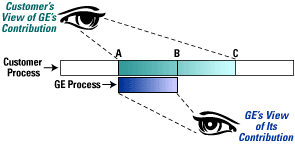What is Six Sigma? - The Roadmap to Customer Impact, from GE.com
Globalization and instant access to information, products and services have changed the way our customers conduct business — old business models no longer work. Today's competitive environment leaves no room for error. We must delight our customers and relentlessly look for new ways to exceed their expectations. This is why Six Sigma Quality has become a part of our culture.
What is Six Sigma? First, what it is not. It is not a secret society, a slogan or a cliché. Six Sigma is a highly disciplined process that helps us focus on developing and delivering near-perfect products and services. Why "Sigma"? The word is a statistical term that measures how far a given process deviates from perfection. The central idea behind Six Sigma is that if you can measure how many "defects" you have in a process, you can systematically figure out how to eliminate them and get as close to "zero defects" as possible. Six Sigma has changed the DNA of GE — it is now the way we work — in everything we do and in every product we design.
There are three key elements of quality: customer, process and employee. Everything we do to remain a world-class quality company focuses on these three essential elements.
1....the Customer: Delighting Customers
Customers are the center of GE's universe: they define quality. They expect performance, reliability, competitive prices, on-time delivery, service, clear and correct transaction processing and more. In every attribute that influences customer perception, we know that just being good is not enough. Delighting our customers is a necessity. Because if we don't do it, someone else will!
2...the Process: Outside-In Thinking
Quality requires us to look at our business from the customer's perspective, not ours. In other words, we must look at our processes from the outside-in. By understanding the transaction lifecycle from the customer's needs and processes, we can discover what they are seeing and feeling. With this knowledge, we can identify areas where we can add significant value or improvement from their perspective.

3...the Employee: Leadership Commitment
People create results. Involving all employees is essential to GE's quality approach. GE is committed to providing opportunities and incentives for employees to focus their talents and energies on satisfying customers.
All GE employees are trained in the strategy, statistical tools and techniques of Six Sigma quality. Training courses are offered at various levels:
- Quality Overview Seminars: basic Six Sigma awareness.
- Team Training: basic tool introduction to equip employees to participate on Six Sigma teams.
- Master Black Belt, Black Belt and Green Belt Training: in-depth quality training that includes high-level statistical tools, basic quality control tools, Change Acceleration Process and Flow technology tools.
- Design for Six Sigma (DFSS) Training: prepares teams for the use of statistical tools to design it right the first time.
Quality is the responsibility of every employee. Every employee must be involved, motivated and knowledgeable if we are to succeed.
From isixsigma: According to the Six Sigma Academy, Black Belts save companies approximately $230,000 per project and can complete four to 6 projects per year. General Electric, one of the most successful companies implementing Six Sigma, has estimated benefits on the order of $10 billion during the first five years of implementation. GE first began Six Sigma in 1995 after Motorola and Allied Signal blazed the Six Sigma trail.






0 Comments:
Post a Comment